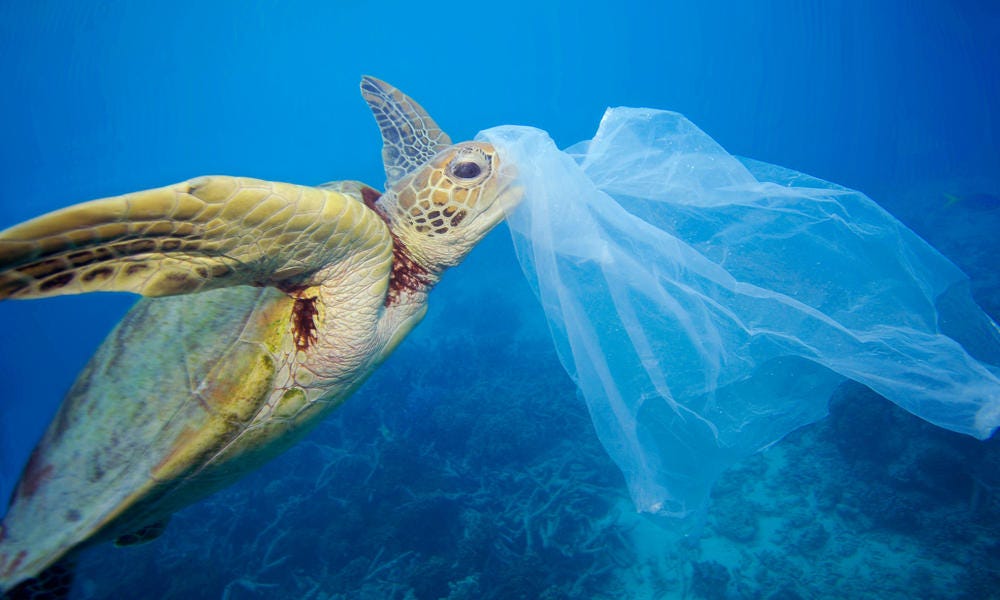What to do with plastic bags?
Shall we ban them? Recycle them? Turn them into building material?
Welcome new subscribers! There are a lot of you in the last couple of weeks. And of course a big hello to all the long-time subscribers to The Green Dispatch.
I’m excited that one of my favorite food writers,
, has started writing on Substack. Adopting a vegan diet is one big step to mitigating climate change, and Susan has some of the tastiest vegan recipes. I highly recommend checking out her Fat Free Vegan NewsBites.Plastic bags are a big problem
When I was a kid, and my folks came home from their weekly trip to the A&P, I’d help put the groceries away. Once we’d gotten all the apples, pork chops, and canned soup in the refrigerator and cupboards, we’d fold up the grocery bags and stash them in our utility room.
Back then, all the grocery bags were paper. We’d find a use for them, carrying hot dogs and buns for a picnic or fetching walnuts from a local field. But most of the old paper bags got tossed in the trash.
Today, I just helped my wife unpack a grocery delivery. All the bags were plastic. We also find secondary uses for these bags, too. In a lot of ways they’re better than paper. They don’t fall apart when they get wet, and they last a long time.
That second quality makes plastic bags convenient and reliable, but it also makes them an environmental problem. The bags my parents brought home from the grocery don’t exist anymore. Once they were thrown in the dump they decomposed quickly. (There could be some of those old bags around, if they had been stored away from damp and sunlight.) On the other hand, for plastic bags, it is estimated to take 1,000 years for them to decompose in landfills. And even then, they are not expected to completely degrade, as paper or wood does. They will become ever smaller bits of microplastic that have their own set of environmental problems.
And there are LOTS of plastic bags. Around 160,000 of them are used every second, amounting to some five trillion bags a year. Besides being unsightly, plastic bags are hazardous to wildlife. Sea turtles often mistake plastic bags floating in the sea for jellyfish, one of their favorite meals. Many turtles die from eating plastic bags. Other animals can get tangled or suffocate in the bags, and there is evidence that even plants can suffer from plastic bags in their environment

.
What to do?
Many places are banning single use plastic bags. New York, Connecticut, Delaware, Maine, Oregon, New Jersey, Vermont, and many of the counties in Hawaii have some sort of plastic bag ban. Colorado is banning them outright. Starting January 1, folks in the Centennial State will be expected to have their own reusable bags at the ready when they go shopping. Otherwise, they can buy paper bags for ten cents. Rhode Island is also joining Colorado in banning plastic bags in 2024. In all, more than 20 states have a ban or some restrictions on plastic bags. On the other hand, since 2008, the state of Florida has restricted its municipalities from banning plastic bags.
Now, I take these bans with a grain of salt. My home state of California has a plastic bag ban, but you wouldn’t know it if you lived here. Retailers in California have simply replaced the thin bags with thicker, brownish plastic bags made of high-density polyethylene, or HDPE. The heftier sacks have those green logos on them, so consumers assume that these bags can be recycled. But that’s not the case at all. The Los Angeles Times contacted municipal and city recycling centers throughout California and did not find a single one that recycles HDPE bags.
This problem goes beyond California. A national online plastic bag recycling directory of some 18,000 recycle drop-off locations has been taken down. This is six months after an investigation by ABC News found that plastic bags dropped off at recycle centers listed in the directory never even got close to a recycling facility. Some of the bags just wound up in landfills, waste facilities, or burned in incinerators. The bag recycling initiative had been promoted by the U.S. Environmental Protection Agency as well as local and state governments throughout the U.S.
Turn those bags into pavers and roof tiles?
A team of researchers in Pakistan melted plastic bags and reformed them as paving blocks and roofing tiles. I don’t know if the Lego folks were involved with the project, but somehow it seems that they should have been.
Some blocks and tiles are made of concrete with plastic mixed in. The Pakistani researchers made tiles and blocks from pure melted-down plastic bags. They got the bags simply from gathering them off the streets of Mirpur, a city in Kashmir. Subjecting the blocks to stress tests, the researchers found that they proved to be good substitutes for concrete blocks. The plastic tiles were found to be better at insulating roofs from outside temperatures, making them a possible replacement for regular roofing tiles. The authors offer this conversion of bags to construction material as a solution to our plastic bag problem. The results of this study were published in the journal Sustainability in November of this year.
Could even more construction material be made of old plastic bags? Or would doing this just be a form of kicking the polymer-encrusted can down the road? Those pavers and tiles will break down as other plastics have, leaving us with the problem of microplastics once again. If you have any thoughts on this subject, please click the “Leave a comment” button below. I’d love to hear what you have to say.




